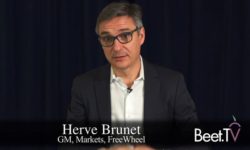MIAMI — The medium of television is moving faster than than it has in decades, maybe even ever, as new opportunities to deliver, measure and monetize programming emerge almost weekly.
In advertising, buyers are getting excited about a world in which planning moves beyond the broad demographic audience targeting of yore, to a world of advanced TV, where granular characteristics and data can help target specific audiences viewing specific content.
But this emerging world is, itself, more granular than simply “advanced TV”. So, how do companies at the vanguard of the revolution make sense of the wealth of different tactics coming in to view?
A panel convened at Beet Retreat debated that question. Here is a flavor of what they said…
Simulmedia VP, Partner Relations, Marc Goldstein:
“There’s just so much out there, and there’s so much happening. What we’re able to do in the national TV space, to be able to find a custom audience to be able to guarantee that audience to be able to guarantee on a conversion to be able guarantee on ROAS (return on ad spend). These are things that we’ve been talking about for a long time and marketers have been talking about but we’re actually seeing them in action.
“The power of the traditional GRP still exists as the power of your television. I think in most cases we’re seeing marketers though realize that we can take portions of their budgets and put it towards these new opportunities.”
IAB mobile and video SVP and GM Anna Bager:
“(Advertisers) need proof points.”
“Where we as the IAB really are going to double down and do research and try and understand better… there’s a lot of questions around six second ads… ‘What does that mean for ad load, and what and in the long run does that mean for us and our profitability, and how are we going to make money here?’
DISH Advanced TV & Digital director Adam Lowy:
“The digital tech stack is opening up a whole new ballgame. You’re just finding an audience and I don’t care if it’s on iOS, Android, PC, Mac, Roku… you know, the DISH set top box doesn’t matter anymore.
“We’re going cross platform pretty soon… (There are) tremendous opportunities within live TV back to the big screen. We see a lot of sessions on mobile devices and we’re seeing a lot of people watching content like this.
“Six-second ads, we will see that. Will we see a collapse of ads and, you know, shorter pods? Yes, I think that works. In live TV, we probably won’t see that.”
Videology GM, Strategic Commercial/Business Development Tony Yi
“There’s certainly service providers that have capabilities technologically to do some of it right now. I think from a mass national level, though, you really need to have respondent level matching with your dataset to truly understand who you’re reaching if you can get device level even better.”
Google Strategic Partner Lead Peter Dolchin:
“Publishers just want optionality at this point. There’s still a very distinct way and legacy way of selling this inventory through upfront and so forth. But there are specific advertisers who are looking for new experiences.
“If you analyzed all your first party data in one place, and Google Cloud can help you do that, it starts to take down all of these silos that exist that have been really difficult for the entire industry. Once you have the ability to have all of your data in one place, you’re able to analyze it in a much faster way.”
The panel was moderated by MediaLink managing director Matt Spiegel.
This video was produced at the Beet Retreat Miami, 2017 presented by Videology along with Alphonso and 605. For more videos from the event, please visit this page.



























